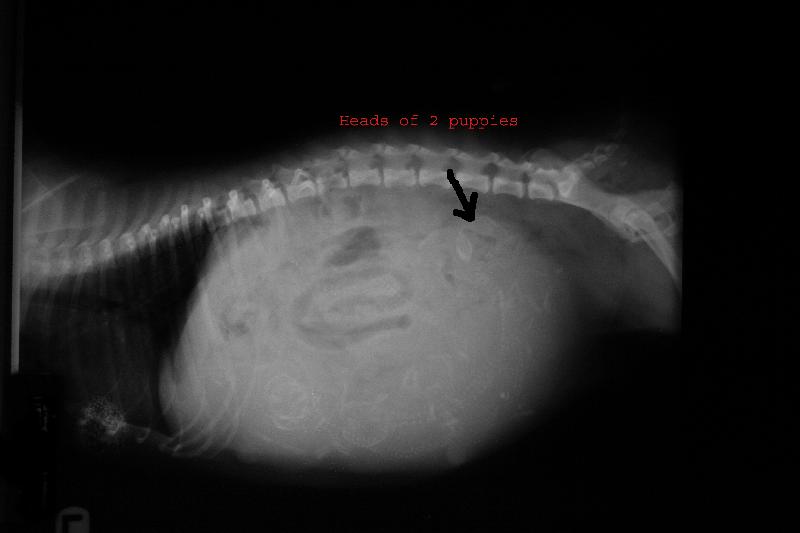|
Canine pregnancy lasts for approximately 63 days, but ranges from 57 to 72 days from a single breeding. This is due to the variability in the ovulation timing and semen survival in the female dog. During this time hormonal and physical changes develop and are observed in the female.
Pregnancy can be diagnosed in a variety of ways in the dog. These include abdominal palpation, ultrasonography, relaxin testing, and radiographs. Each method has its own specific time frame when it is most accurate in determination of pregnancy.
Abdominal palpation can be performed if the female is cooperative. Many times in a nervous female, the uterus can not be felt due to a tense abdomen. Pregnancy is most accurately identified by this method at about days 28 to 30 after ovulation. It can also be difficult to palpate and determine pregnancy in large dogs and in dogs with just a few pups in the cranial part of the abdomen.
Radiographic diagnosis of pregnancy is first possible 42 to 50 days after first mating. It is usually recommended to wait until later in the pregnancy to obtain a puppy count with radiographs as it can be difficult to visualize all the puppies in early films. For the most accurate puppy numbers, radiographs should be taken at about day 55 post first breeding.

Relaxin canine pregnancy test can be used to diagnose pregnancy as early as day 21 to 28 post breeding. Relaxin is a pregnancy specific hormone that is produced primarily by the canine placenta. False negative can occur, and negative results should be confirmed by other testing or by repeating the test in 7 to 10 days.
Ultrasound pregnancy confirmation is possible as early as day 20-22 after breeding, but can be missed this early. Ultrasound at day 30 post breeding is a great diagnositc tool to confirm pregnancy. Ultrasound has the drawback of not being accurate to count puppies, but can determine heartbearts in the puppies.
Other issues with pregnancy include exacerbation of underlying disease such as heart disease, diabetes mellitus, pregnancy toxemia, and kidney disease or infection. Because of the significant physiologic changes that occur in a pregnant dog, it is extremely important for the dog to be healthy PRIOR to breeding. Any underlying diseases need to be evaluated and treated. The implications for pregnancy with any underlying disease needs to be discussed to determine if the dog should be bred or not.
Nutrition during pregnancy is also a subject of which many questions arise. A normal maintenance diet should be fed during the first two thirds (6 weeks) of the pregnancy. Less than 30 % of fetal growth is in the first 6 weeks, so there is little change in nutritional requirements at this stage in pregnancy. During the last 3 to 4 weeks of pregnancy, the fetal growth rapidly increases. A gradual increase in food should be instituted to effect a 25% increase by whelping. The food is often switched to a higher protein, carbohydrate, and mineral diet (often a high quality puppy food). This can vary depending on the size of the litter and the type of dog.
Calcium supplementation should NOT be started unless prescribed by a veterinarian until after whelping. Calcium supplementation prior to whelping can be associated with increased dystocia, eclampsia, and problems with the litter. Other medications should be given only on the advice of a veterinarian. Heartguard Plus (a heartworm preventative) and Frontline (flea control) should be continued. If there are any concerns about any long term medication, discuss this with the veterinarian prior to breeding.
|